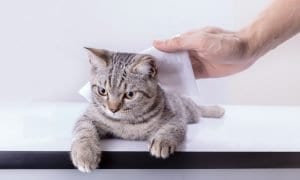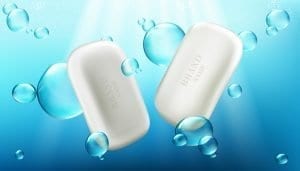Cats are one of the most hygienic pets you can own, but that does not stop us from washing them from time to time. Some cat parents use cat shampoo, and others use soap, while others even use human shampoo. However, some pet parents worry that some kinds of cat shampoo might be bad for their cats.
Therefore, we are left with these questions: is human shampoo toxic for cats? Can you bathe your cat with other shower products? And how to wash a cat without cat shampoo?
NOTE: We want to inform our blog readers that before we publish any article, the team “Proudcatowners” does deep research based on experience and knowledge about cats and everything related to them, to guarantees reliable and precise information, satisfy the readers is our first priority.
How to wash a cat without cat shampoo?
You can use several methods to bathe your cat without using cat shampoo, such as baby shower, soap, only water, or giving your cat a dry bath.
What do we mean by a dry bath?
A dry bath is an option that many pet parents opt for because it is less messy. In addition to that, many cat parents prefer dry baths during winter, so their cat does not catch a cold. Wiping your cat with cat bath wipes or a washcloth is considered a dry bath most of the time.
A dry shower can also include cat bathing power, or foam, which is also referred to as water-less cat shampoo. Ensure that the products you use are made for the feline population, and do not contain any toxic chemicals that might harm your cat.
How can I give my cat a dry bath?
Some pet owners choose to use wet wipes, for example, from any brand. You must check that these wet wipes are not toxic for your cat, nor contain any chemicals that could be harmful to your cat. It is advised against because it can irritate your cat’s skin. There are also cat bath wipes that are made specifically for cats.
They are similar to baby wipes, but these are specifically made for your little paw friend. You can purchase them at a local pet store, or order them online. There are pet parents who tend to use a washcloth and some warm water to wipe off their cat’s fur. Warm water is optional, but the majority of cat parents tend to use it because their cat is sensitive, can catch a cold easily, or do not want to alarm their cat.
How to clean your cat with wipes

Cat bath wipes have a lovely smell that they leave stuck in your cat’s fur for some time, and they can clean up its coat very thoroughly. Approach your cat when it is relaxed and having a good and calm time, and avoid cleaning or grooming your cat when it is agitated, stressed, or irritated.
Start by petting your cat with your hand before touching it with the wipes, so that your cat can get used to it and be comfortable with it. Start rubbing your cat with the wipes slowly and gently, and keep up the same rhythm.
Pet your cat frequently when using the wipes, so that it does not get alarmed by the process. Massage your cat and make sure it enjoys this water-free bath by using long strokes that help with disturbing essential oils from the wipes to your cat’s coat. Wipe your cat’s face and ears, and do not forget to wipe its paws as well. The same method can be used with wet wipes and washcloths.
Warning: before trying any new products on your cat, make sure you consult with your veterinarian first and check the products for any toxic materials or products that could irritate your cat’s skin or its allergies.
How can I use powder to clean my cat?
Distribute the powder directly onto your cat’s fur, and brush it thoroughly. There are cat grooming brushes which you can use to brush your cat’s fur, and eliminate all the excess powder from the cat’s coat. One of the disadvantages of cat grooming powders is that it can leave white or light spots on the cat’s fur and be messier than the other dry bath methods.
What about cat foam?
Cat foam or water-less/dry cat shampoo is more practical to use than grooming powder. You can apply the foam directly on your cat’s fur, the quantity you apply depends on the instructions written on the box. Distribute the foam equitably on the cat’s coat and massage it while you do that so that it stays calm. Remove any excess amounts of foam, and then brush the cat’s fur thoroughly with a grooming brush.
Make sure you choose a non-toxic and an all-natural product to wash your cat without cat shampoo. It is best to choose a product that has been recommended by veterinarians before, and that has good recommendations from other cat parents. Choosing the right product would help you avoid any complications or problems with your cat’s coat, or resulting in a dry and shine-free fur.
Some of the best cat products for dry baths
- RELIEF FOR SENSITIVE SKIN – Vet’s Best Waterless Cat Shampoo cleans, conditions, moisturizes, and soothes itchy, dry skin & coat, leaving your cat clean and soft
- Smelly pet? No time to give a bath? No problem! Our dry shampooo is organic, gentle and easy to use. A little bit goes a long ways. Great for pets with allergies and sensative skin. Free of dyes, parabens, chemical preservatives, synthetic fragrances,
- #1 PET GROOMING BRAND IN THE USA*-Join the millions of pet parents who can-t get enough of Burt-s Bees for Pets by using America-s #1 pet grooming brand
Myth or truth: I can bathe my cat using vinegar
This statement is true. Many pet parents advise adding a cup of vinegar to your cat’s bathtub when it is shower time. Do not add too much vinegar so that your cat would not be repelled, a cup of vinegar in a gallon of water is good enough, although some pet parents use even less than one cup of vinegar in warm water give their cats a joyful and relaxing bath.
Many pet parents said they adopted this method because their cat had dandruff or fleas in its coat, and this method helped a lot with getting rid of these problems. Make sure you consult your veterinarian before trying this bathing method on your cat.
Benefits of water and vinegar bath for your cat
- Natural repellent to fleas and ticks
- Cure to your cat’s dandruff problem
- A good treatment for your cat’s coat
- Cleanses the cat’s body of toxins
- Works as an immunity booster
How can I use vinegar in my cat’s bath?
Start by filling up your cat’s tub with some water, preferably warm water, then add a small amount of vinegar to it. Wash your kitty in this vinegar water as if you are giving it a natural soap shower. Rinse the cat’s coat and fur thoroughly, rub it with your hands gently and scrub your cat’s skin softly.
Avoid touching your cat’s eyes and other sensitive areas. After you are done with the vinegar bath, rinse your little paw friend and wrap it in a towel to dry it up. The smell of vinegar would only last for a few minutes and disappear on its own.
Soap

Picking a good soap is essential for your cat’s healthy and shiny coat. Preparing a bath with some water and soap in it can help you clean your cat’s fur from all the substances that might be stuck in it. It helps remove the greasy and sticky matters as well. Avoid rubbing the bar of soap too hard directly on your cat’s skin. Work in the same direction, from the head to the tail, and make sure you wash off all the soap from your cat’s body after you are done.
In addition to the previous methods, some pet parents use only plain water for bathing their cats. If your cat is not too dirty, and you do not need to get anything sticky or oily off its coat, giving a shower with simply water would be alright.
Can I use human products on my cat?
When it comes to bathing your cat, human shampoo, body wash, soap, or any other human shower products are all advised against. The entire feline population, including your cat, has different pH levels than humans. Personal products such as shampoo have a balanced Ph level that is made to fit our pH levels, and not our cat’s levels.
Our bath products can cause skin problems for our cats, especially if we use them regularly. It can lead to a dry coat, loss of fur, bald spots, and even skin allergies. Avoid using any product that could harm your cat, and make sure you always consult with your veterinarian before choosing which product to use.
Is it okay to use baby shampoo on my cat?
Any human product is advised against, whether it is an adult or a baby product. Although unscented baby shampoo can be used in some cases, it can harm your cat if you do not handle it with care. It is better to avoid using any human product and only use products made for the feline population.
What about neutral soap?
Neutral soaps are safe for humans, but they can still pose a significant danger to cats. There are some plant-based essential oils in these kinds of soap that give them a lovely aroma, and although it is a pleasure to smell them, and they can be useful for our skin, it can still harm our little paw friend. Some studies have shown that essential oils are toxic for cats because their bodies do not produce the necessary enzyme it takes to break down these oils.
And as we know, our cat’s skin can absorb these oils, just like our skin can. Some of these essential oils are peppermint oil, cinnamon oil, citrus oil, and pine oil. These later are rich in phenol and phenolic compounds, which are extremely toxic for cats.
If you expose your cat to these oils, it can experience some health conditions and show symptoms such as vomiting, shaking, decreased body temperature. In severe cases, your case can even develop liver disease.
Can I use dog shampoo or dog soap on my cat?

Dog shampoo and dog soap are made for dogs only, and not for cats. It could contain ingredients that might harm your cat, such as certain essential oils, fragrances, additives, or insecticides. These ingredients are safe for dogs, and they would not put them in danger or harm their skin, but they can be harmful and even toxic for your cat.
What should I do?
Avoid using any products that are not made for the feline population. You should always check the components of any product you use and make sure they are not harmful to your cat. Always consult with your veterinarian and seek medical advice on which product to use, and which product to avoid. When using a certain kind of shampoo or soap, read the instructions concerning how much you should use during a bath. Using too much can harm your cat’s coat. Cats are hygienic creatures, avoid washing their skin regularly, unless they need it.
Truth or myth: Dawn Dish Soap is safe for cats
Although it is always better to use products that are made specifically for cats, many pet parents agree that Dawn dish soap is safe to use on cats. This dish soap can be used instead of shampoo if you want to give your cat a little shower, as long as you use it with moderation, and consult your veterinarian first.
Other safe products you can use when washing your cat
- gentle clean that wont irritate your babys delicate eyes during bath time Developed with and tested by parents, this nourishing tear-free baby shampoo is mild enough for your babys fine hair and delicate scalp while
- 3X MORE CONCENTRATED THAN MOST LIQUID SOAPS: Dilute! Dilute! Multiple uses for just one product: laundry, mopping, hand-washing dishes, all-purpose cleaning, washing pets & more. More soap per bottle means less waste in packaging!
- 50 percent Less Scrubbing Contains 3x Grease Cleaning Power (cleaning ingredients per drop vs. Dawn Non-Concentrated)
Harmful cleaning chemicals for your cat
There are some chemicals we use around the house, which are toxic for our cats, and should be handled carefully. Such as flea control chemicals, lawn fertilizers, anti-freeze, and mothballs. We often think that because these products are beneficial, they do not pose any danger for our cats, but it is quite the opposite. Make sure you keep these cleaning products away from your cat, and never use them near your cat, or in an attempt to wash a cat without cat shampoo.
Homemade shampoo for cats
In case you run out of cat shampoo or simply did not find the suitable type for your cat, there are several ways you can make your cat shampoo at home.
This first one is for making a regular homemade shampoo, and it is effortless. You only need two cups of warm water, half a cup of apple cider, and one-quarter of a cup of Dawn dishwashing liquid soap. Mix all three ingredients in a plastic bottle until bubbles begin to form, then you are all set to go. Your homemade shampoo is ready for use.
In case your cat has sensitive skin and needs extra care, here is another recipe for a gentle homemade shampoo:
You will need 4 cups of warm water, one cup of ground organic oatmeal, one cup of baking soda, and one teaspoon of Dawn dishwashing liquid soap. Mix all four ingredients in a plastic bottle or in a covered container, and your gentle shampoo is ready for your little sensitive paw friend. Oatmeal and baking powder would help soothe its fur, hydrate its coat and skin, and clean it thoroughly.
My cat hates showering, and it keeps scratching me, what should I do?
The majority of the feline population hates showering and dislikes water. In most cases, you do not need to wash your cat every week or regularly, because cats already know how to keep themselves clean and take care of their hygiene. However, you should wash your cat from time, especially if its fur got dirty, and it needs a deep cleaning. In case you struggled with washing your cat before, and you ended looking like you left a war zone after washing the cat, here are the steps to bathe a cat, and some tips that can help you survive bathing your cat, without being bitten or scratched.
The steps of washing your cat
- Fill in your tub with some warm water.
- Put a mat to prevent your cat from slipping in the tub.
- Gently place the cat in the tub
- Pet your cat to keep it calm and relaxed
- Put water on your cat slowly using a cup or your hand
- Wet your cat thoroughly
- Add the cat’s shampoo or soap
- Rinse your cat slowly, and with a steady rhythm
- Maintain the direction of rubbing
- Do not be too rough when cleaning the cat’s coat
- Do not forget to clean its paws
- Rinse your cat gently
- Pick it up and wrap it in a towel
- Place your cat in a warm place
- Groom its fur and give it a small massage
- You can use some cotton balls to clean your cat ears gently, without pushing it inside the ears, and a washcloth to clean the cat’s face. If your cat has long fur and it is terrified by the sound of a blow drier, use one to dry its coat. If it gets scared, use a towel to dry your cat and keep it warm. Treat your cat after the shower with a small kibble or some of its favorite cat snack food.
Before putting your cat in the shower, prepare everything, brush its fur, and make sure you trim its claws first so that it does scratch you while you are washing it. Avoid using the faucet or the showerhead to wash your cat, because that could alarm it.
Conclusion
Most cats do not enjoy taking a bath, but there are some instances in which we must wash out little paw friends. There are pet parents who use different kinds of shower products when washing their cats, and some do not use cat shampoo at all.
You can use several products to wash your cat instead of cat shampoos, such as foam, cat bath wipes, washcloths, water and vinegar, soap, Johnson’s baby shampoo, and Dawn dishwashing liquid soap. Avoid using any human or neutral products because they can be harmful to your cat, or contain some toxic ingredients.
Neutral products such as neutral soap contain essential oils that are toxic for your cat and could lead to severe health conditions if the skin absorbs too much of it. There are also some easy recipes you can follow to make a homemade shampoo for your cat. Always consult your veterinarian before trying any new products, and seek proper advice on how to wash a cat without cat shampoo.










